The Sound of a Circular City: Towards a Circularity-Driven Quietness
Abstract
:1. Introduction
2. Background
2.1. Circular Economy and Urban Sustainability
- Resource looping incorporating reuse and recycling systems such as gray water re-purposing;
- Adaptation schemes such as flexible infrastructure, according to the changing needs of a community;
- Ecological regeneration that involves the promotion of natural cycles, thus improving well-being [25];
- Sharing of products and digital tools to facilitate the procedure;
- Optimization of the energy production towards local and renewable methods;
- Upgrading of buildings, e.g., with green walls and green rooftops; and
- Mobility systems that are compatible with a more sustainable way of commuting [4].
2.2. The Linearity of Noise Control and the Circular Approach towards Urban Quietness
2.3. Circular Development Actions That Benefit the Urban Sound Environment
2.3.1. Urban Green Infrastructure
2.3.2. Circular Mobility
3. Materials and Methods
3.1. Case Study Area
3.2. Environmental Noise Assessment, Noise Modeling and Receiver Noise Exposure Mapping Techniques
- Constant vehicle speeds;
- Flat roads;
- Air temperature τ ref = 20 °C;
- Dry road surfaces; and
- No studded tires.
- Detailed cartographic representation of the area under consideration (buildings, roads, vegetation).
- Building height and location: In this case, the highest building was 20 m high.
- Façade material type: In this case, the surrounding buildings’ façades consist of a mixture of concrete and glass materials.
- Vegetation height and location.
- Road type classification (motorway, ordinary road, local).
- Road surface type: In this case, it was asphalt concrete.
- Traffic light location and operation: In this case, 4 traffic lights that do not operate during the night period.
- Vehicle speed: In this case, 50 km/h for passenger vehicles and motorcycles and 40 km/h for trucks, according to the Greek legislation.
3.3. A Methodological Approach towards a Circular Acoustic Urban Environment Assessment—Modifying the Absorption Coefficient of Façades and Correcting Electric Vehicle Propulsion Noise
4. Results
5. Discussion
Limitations and Future Work
6. Conclusions
Author Contributions
Funding
Institutional Review Board Statement
Informed Consent Statement
Data Availability Statement
Acknowledgments
Conflicts of Interest
References
- Rudd, N.; Courtney, E. Juvenal: Satires I, III, X; Bristol Classical Press: Bristol, UK, 1990. [Google Scholar]
- Attali, J. Noise: The Political Economy of Music; Manchester University Press: Manchester, UK, 1985; ISBN 978-0-7190-1471-0. [Google Scholar]
- Thurston, F.E. The Worker’s Ear: A History of Noise-Induced Hearing Loss. Am. J. Ind. Med. 2013, 56, 367–377. [Google Scholar] [CrossRef] [PubMed]
- Paiho, S.; Mäki, E.; Wessberg, N.; Paavola, M.; Tuominen, P.; Antikainen, M.; Heikkilä, J.; Rozado, C.A.; Jung, N. Towards Circular Cities—Conceptualizing Core Aspects. Sustain. Cities Soc. 2020, 59, 102143. [Google Scholar] [CrossRef]
- Kang, J. From DBA to Soundscape Indices: Managing Our Sound Environment. Front. Eng. 2017, 4, 184–192. [Google Scholar] [CrossRef]
- Correia, C.R.; Roseland, M. Addressing Negative Externalities of Urban Development: Toward a More Sustainable Approach. Urban Sci. 2022, 6, 38. [Google Scholar] [CrossRef]
- Environmental Noise Guidelines for the European Region. Available online: https://www.who.int/europe/publications/i/item/9789289053563 (accessed on 14 June 2022).
- Environmental Noise Guidelines for the European Region. 2018. Available online: https://www.euro.who.int/en/health-topics/environment-and-health/noise/publications/2018/environmental-noise-guidelines-for-the-european-region-2018 (accessed on 29 May 2022).
- Oertli, J. Cost–Benefit Analysis in Railway Noise Control. J. Sound Vib. 2000, 231, 505–509. [Google Scholar] [CrossRef]
- Puppim de Oliveira, J.A.; Bellezoni, R.A.; Shih, W.; Bayulken, B. Innovations in Urban Green and Blue Infrastructure: Tackling Local and Global Challenges in Cities. J. Clean. Prod. 2022, 362, 132355. [Google Scholar] [CrossRef]
- Oliveira, J.A.P. de Sustainability Challenges in an Urban Century: Can We Change Urbanization Paths to Make Cities the Solutions for Rather than the Drivers of Global Problems? Chall. Sustain. 2019, 7, 1–4. [Google Scholar] [CrossRef]
- Susskind, L.; Kim, A. Building Local Capacity to Adapt to Climate Change. Clim. Policy 2022, 22, 593–606. [Google Scholar] [CrossRef]
- Byrne, L.B. Ecology with Cities. Urban Ecosyst. 2022, 25, 835–837. [Google Scholar] [CrossRef]
- Urban Population (% of Total Population)—European Union|Data. Available online: https://data.worldbank.org/indicator/SP.URB.TOTL.IN.ZS?locations=EU (accessed on 25 July 2022).
- Urban Population (% of Total Population)|Data. Available online: https://data.worldbank.org/indicator/SP.URB.TOTL.IN.ZS (accessed on 25 July 2022).
- Urban Environment—European Environment Agency. Available online: https://www.eea.europa.eu/themes/urban/intro (accessed on 28 May 2022).
- Sharifi, A.; Pathak, M.; Joshi, C.; He, B.-J. A Systematic Review of the Health Co-Benefits of Urban Climate Change Adaptation. Sustain. Cities Soc. 2021, 74, 103190. [Google Scholar] [CrossRef]
- Spiliotopoulou, M.; Roseland, M. Urban Sustainability via Urban Productivity? A Conceptual Review and Framework Proposal. Local Environ. 2022, 27, 177–196. [Google Scholar] [CrossRef]
- Zeng, X.; Yu, Y.; Yang, S.; Lv, Y.; Sarker, M.N.I. Urban Resilience for Urban Sustainability: Concepts, Dimensions, and Perspectives. Sustainability 2022, 14, 2481. [Google Scholar] [CrossRef]
- Ganten, D.; Haines, A.; Souhami, R. Health Co-Benefits of Policies to Tackle Climate Change. Lancet 2010, 376, 1802–1804. [Google Scholar] [CrossRef]
- Balletto, G.; Ladu, M.; Milesi, A.; Camerin, F.; Borruso, G. Walkable City and Military Enclaves: Analysis and Decision-Making Approach to Support the Proximity Connection in Urban Regeneration. Sustainability 2022, 14, 457. [Google Scholar] [CrossRef]
- dos Santos Figueiredo, Y.D.; Prim, M.A.; Dandolini, G.A. Urban Regeneration in the Light of Social Innovation: A Systematic Integrative Literature Review. Land Use Policy 2022, 113, 105873. [Google Scholar] [CrossRef]
- Williams, J. Circular Cities. Urban Stud. 2019, 56, 2746–2762. [Google Scholar] [CrossRef]
- Williams, J. The Role of Spatial Planning in Transitioning to Circular Urban Development. Urban Geogr. 2020, 41, 915–919. [Google Scholar] [CrossRef]
- Williams, J. Circular Cities: What Are the Benefits of Circular Development? Sustainability 2021, 13, 5725. [Google Scholar] [CrossRef]
- Geissdoerfer, M.; Savaget, P.; Bocken, N.M.P.; Hultink, E.J. The Circular Economy—A New Sustainability Paradigm? J. Clean. Prod. 2017, 143, 757–768. [Google Scholar] [CrossRef]
- Aegean Bioeconomy Aegean Bioeconomy-Center for Sustainable Circular Bioeconomy and Energy. Available online: https://bioeconomy.aegean.gr/en (accessed on 24 August 2022).
- Feleki, E.; Achillas, C.; Vlachokostas, C.; Michailidou, A.V.; Ortega, L.; Moussiopoulos, N. Preservation of the Mediterranean Identity: An Intra-City Analysis Towards a Macro-Regional Approach for the Characterisation of Urban Sustainability. Sustainability 2018, 10, 3551. [Google Scholar] [CrossRef] [Green Version]
- Martí, P.; Nolasco-Cirugeda, A.; Serrano-Estrada, L. Assessment Tools for Urban Sustainability Policies in Spanish Mediterranean Tourist Areas. Land Use Policy 2017, 67, 625–639. [Google Scholar] [CrossRef]
- The Circular Economy in Detail. Available online: https://archive.ellenmacarthurfoundation.org/explore/the-circular-economy-in-detail (accessed on 24 August 2022).
- Coskun, A.; Metta, J.; Bakırlıoğlu, Y.; Çay, D.; Bachus, K. Make It a Circular City: Experiences and Challenges from European Cities Striving for Sustainability through Promoting Circular Making. Resour. Conserv. Recycl. 2022, 185, 106495. [Google Scholar] [CrossRef]
- McCormick, K.; Kautto, N. The Bioeconomy in Europe: An Overview. Sustainability 2013, 5, 2589–2608. [Google Scholar] [CrossRef]
- Hurmekoski, E.; Lovrić, M.; Lovrić, N.; Hetemäki, L.; Winkel, G. Frontiers of the Forest-Based Bioeconomy—A European Delphi Study. For. Policy Econ. 2019, 102, 86–99. [Google Scholar] [CrossRef]
- Actions Framework—Circulars. Available online: https://circulars.iclei.org/action-framework/ (accessed on 12 September 2022).
- Circular Cities Hub. Available online: http://circularcitieshub.com/ (accessed on 12 September 2022).
- Andreucci, M.B.; Croci, E. Assessing Integrated Circular Actions as Nexus Solutions Across Different Urban Challenges: Evidence Toward a City-Sensitive Circular Economy. In Smart and Sustainable Planning for Cities and Regions: Results of SSPCR 2019; Bisello, A., Vettorato, D., Haarstad, H., Borsboom-van Beurden, J., Eds.; Green Energy and Technology; Springer International Publishing: Cham, Germany, 2021; pp. 215–225. ISBN 978-3-030-57332-4. [Google Scholar]
- Prendeville, S.; Cherim, E.; Bocken, N. Circular Cities: Mapping Six Cities in Transition. Environ. Innov. Soc. Transit. 2018, 26, 171–194. [Google Scholar] [CrossRef]
- Quam, V.G.M.; Rocklöv, J.; Quam, M.B.M.; Lucas, R.A.I. Assessing Greenhouse Gas Emissions and Health Co-Benefits: A Structured Review of Lifestyle-Related Climate Change Mitigation Strategies. Int. J. Environ. Res. Public Health 2017, 14, 468. [Google Scholar] [CrossRef]
- Sparkman, G.; Attari, S.Z. Credibility, Communication, and Climate Change: How Lifestyle Inconsistency and Do-Gooder Derogation Impact Decarbonization Advocacy. Energy Res. Soc. Sci. 2020, 59, 101290. [Google Scholar] [CrossRef]
- Saleem, S.B.; Ali, Y. Effect of Lifestyle Changes and Consumption Patterns on Environmental Impact: A Comparison Study of Pakistan and China. Chin. J. Popul. Resour. Environ. 2019, 17, 113–122. [Google Scholar] [CrossRef]
- Mahmud, S.A.; Ahmad, A.S.; Abdullah, A.M. Lifestyle Orientation and the Residential Environment: An Exploratory Review. Procedia—Soc. Behav. Sci. 2012, 49, 304–309. [Google Scholar] [CrossRef]
- Herman, K.; Drozda, Ł. Green Infrastructure in the Time of Social Distancing: Urban Policy and the Tactical Pandemic Urbanism. Sustainability 2021, 13, 1632. [Google Scholar] [CrossRef]
- Asensio, C.; Pavón, I.; de Arcas, G. Changes in Noise Levels in the City of Madrid during COVID-19 Lockdown in 2020. J. Acoust. Soc. Am. 2020, 148, 1748–1755. [Google Scholar] [CrossRef] [PubMed]
- Aletta, F.; Oberman, T.; Mitchell, A.; Tong, H.; Kang, J. Assessing the Changing Urban Sound Environment during the COVID-19 Lockdown Period Using Short-Term Acoustic Measurements. Noise Mapp. 2020, 7, 123–134. [Google Scholar] [CrossRef]
- Nieuwenhuijsen, M.J. New Urban Models for More Sustainable, Liveable and Healthier Cities Post Covid19; Reducing Air Pollution, Noise and Heat Island Effects and Increasing Green Space and Physical Activity. Environ. Int. 2021, 157, 106850. [Google Scholar] [CrossRef] [PubMed]
- Mitchell, A.; Oberman, T.; Aletta, F.; Kachlicka, M.; Lionello, M.; Erfanian, M.; Kang, J. Investigating Urban Soundscapes of the COVID-19 Lockdown: A Predictive Soundscape Modeling Approach. J. Acoust. Soc. Am. 2021, 150, 4474–4488. [Google Scholar] [CrossRef]
- Aumond, P.; Can, A.; Lagrange, M.; Gontier, F.; Lavandier, C. Multidimensional Analyses of the Noise Impacts of COVID-19 Lockdown. J. Acoust. Soc. Am. 2022, 151, 911–923. [Google Scholar] [CrossRef]
- Torresin, S.; Albatici, R.; Aletta, F.; Babich, F.; Oberman, T.; Kang, J. Associations between Indoor Soundscapes, Building Services and Window Opening Behaviour during the COVID-19 Lockdown. Build. Serv. Eng. Res. Technol. 2022, 43, 225–240. [Google Scholar] [CrossRef]
- Torresin, S.; Albatici, R.; Aletta, F.; Babich, F.; Oberman, T.; Stawinoga, A.E.; Kang, J. Indoor Soundscapes at Home during the COVID-19 Lockdown in London—Part I: Associations between the Perception of the Acoustic Environment, Occupantś Activity and Well-Being. Appl. Acoust. 2021, 183, 108305. [Google Scholar] [CrossRef]
- Zhao, Z.; Wang, Y.; Hou, Y. Residents’ Spatial Perceptions of Urban Gardens Based on Soundscape and Landscape Differences. Sustainability 2020, 12, 6809. [Google Scholar] [CrossRef]
- Fang, X.; Gao, T.; Hedblom, M.; Xu, N.; Xiang, Y.; Hu, M.; Chen, Y.; Qiu, L. Soundscape Perceptions and Preferences for Different Groups of Users in Urban Recreational Forest Parks. Forests 2021, 12, 468. [Google Scholar] [CrossRef]
- Ma, K.W.; Mak, C.M.; Wong, H.M. Effects of Environmental Sound Quality on Soundscape Preference in a Public Urban Space. Appl. Acoust. 2021, 171, 107570. [Google Scholar] [CrossRef]
- Tokue, Y.; Koga, K.; Nakamura, A.; Osawa, K.; Seki, K.; Imamura, F.; Nishihiro, J. Effects of Hearing Diverse Orthoptera Sounds on Human Psychology. Urban For. Urban Green. 2022, 73, 127512. [Google Scholar] [CrossRef]
- Novianto, D.; Koerniawan, M.D.; Munawir, M.; Sekartaji, D. Impact of Lifestyle Changes on Home Energy Consumption during Pandemic COVID-19 in Indonesia. Sustain. Cities Soc. 2022, 83, 103930. [Google Scholar] [CrossRef] [PubMed]
- Brueckner, J.K.; Helsley, R.W. Sprawl and Blight. J. Urban Econ. 2011, 69, 205–213. [Google Scholar] [CrossRef]
- Shamsipour, M.; Zaredar, N.; Monazzam, M.R.; Namvar, Z.; Mohammadpour, S. Burden of Diseases Attributed to Traffic Noise in the Metropolis of Tehran in 2017. Environ. Pollut. 2022, 301, 119042. [Google Scholar] [CrossRef] [PubMed]
- Tong, H.; Kang, J. Relationship between Urban Development Patterns and Noise Complaints in England. Environ. Plan. B Urban Anal. City Sci. 2021, 48, 1632–1649. [Google Scholar] [CrossRef]
- Lam, B.; Gan, W.-S.; Shi, D.; Nishimura, M.; Elliott, S. Ten Questions Concerning Active Noise Control in the Built Environment. Build. Environ. 2021, 200, 107928. [Google Scholar] [CrossRef]
- Lu, L.; Yin, K.-L.; de Lamare, R.C.; Zheng, Z.; Yu, Y.; Yang, X.; Chen, B. A Survey on Active Noise Control in the Past Decade—Part I: Linear Systems. Signal Process. 2021, 183, 108039. [Google Scholar] [CrossRef]
- Zhang, Z.; Chen, S.; Zhou, Z.; Li, H. An Active Noise Control System Based on Reference Signal Decomposition. Digit. Signal Process. 2022, 129, 103676. [Google Scholar] [CrossRef]
- Yang, W.; He, J.; He, C.; Cai, M. Evaluation of Urban Traffic Noise Pollution Based on Noise Maps. Transp. Res. Part D Transp. Environ. 2020, 87, 102516. [Google Scholar] [CrossRef]
- Moroe, N.; Mabaso, P. Quantifying Traffic Noise Pollution Levels: A Cross-Sectional Survey in South Africa. Sci. Rep. 2022, 12, 3454. [Google Scholar] [CrossRef]
- Hao, G.; Zuo, L.; Weng, X.; Fei, Q.; Zhang, Z.; Chen, L.; Wang, Z.; Jing, C. Associations of Road Traffic Noise with Cardiovascular Diseases and Mortality: Longitudinal Results from UK Biobank and Meta-Analysis. Environ. Res. 2022, 212, 113129. [Google Scholar] [CrossRef] [PubMed]
- May, D.N.; Osman, N.M. Highway Noise Barriers: New Shapes. J. Sound Vib. 1980, 71, 73–101. [Google Scholar] [CrossRef]
- Hothersall, D.C.; Chandler-Wilde, S.N.; Hajmirzae, M.N. Efficiency of Single Noise Barriers. J. Sound Vib. 1991, 146, 303–322. [Google Scholar] [CrossRef]
- Redondo, J.; Gaja-Silvestre, P.; Godinho, L.; Amado-Mendes, P. A Simple Method to Estimate the In Situ Performance of Noise Barriers. Appl. Sci. 2022, 12, 7027. [Google Scholar] [CrossRef]
- Kesten, S.; Umut, Ö.; Ayva, B. Acoustic and Structural Design of a Highway Noise Barrier. IOP Conf. Ser. Mater. Sci. Eng. 2020, 800, 012029. [Google Scholar] [CrossRef]
- Huang, H.; Qiu, X.; Kang, J. Active Noise Attenuation in Ventilation Windows. J. Acoust. Soc. Am. 2011, 130, 176–188. [Google Scholar] [CrossRef]
- Secchi, S.; Astolfi, A.; Calosso, G.; Casini, D.; Cellai, G.; Scamoni, F.; Scrosati, C.; Shtrepi, L. Effect of Outdoor Noise and Façade Sound Insulation on Indoor Acoustic Environment of Italian Schools. Appl. Acoust. 2017, 126, 120–130. [Google Scholar] [CrossRef]
- Gidlöf-Gunnarsson, A.; Öhrström, E. Attractive “Quiet” Courtyards: A Potential Modifier of Urban Residents’ Responses to Road Traffic Noise? Int. J. Environ. Res. Public Health 2010, 7, 3359–3375. [Google Scholar] [CrossRef]
- Costanza, R.; de Groot, R.; Sutton, P.; van der Ploeg, S.; Anderson, S.J.; Kubiszewski, I.; Farber, S.; Turner, R.K. Changes in the Global Value of Ecosystem Services. Glob. Environ. Chang. 2014, 26, 152–158. [Google Scholar] [CrossRef]
- Kang, J.; Aletta, F.; Gjestland, T.T.; Brown, L.A.; Botteldooren, D.; Schulte-Fortkamp, B.; Lercher, P.; van Kamp, I.; Genuit, K.; Fiebig, A.; et al. Ten Questions on the Soundscapes of the Built Environment. Build. Environ. 2016, 108, 284–294. [Google Scholar] [CrossRef] [Green Version]
- Brambilla, G.; Maffei, L. Perspective of the Soundscape Approach as a Tool for Urban Space Design. Noise Control Eng. J. 2010, 58, 532–539. [Google Scholar] [CrossRef]
- Liu, Y.; Huang, Y.; Zhang, Z.; Wang, K.; Luo, Y.; Cui, P. Impacts of Green Walls on the Characteristics of Thermo-Flow and Photochemical Reaction Kinetics within Street Canyons. Urban For. Urban Green. 2022, 72, 127568. [Google Scholar] [CrossRef]
- Fountoulakis, M.S.; Markakis, N.; Petousi, I.; Manios, T. Single House On-Site Grey Water Treatment Using a Submerged Membrane Bioreactor for Toilet Flushing. Sci. Total Environ. 2016, 551–552, 706–711. [Google Scholar] [CrossRef]
- Kotsia, D.; Deligianni, A.; Fyllas, N.M.; Stasinakis, A.S.; Fountoulakis, M.S. Converting Treatment Wetlands into “Treatment Gardens”: Use of Ornamental Plants for Greywater Treatment. Sci. Total Environ. 2020, 744, 140889. [Google Scholar] [CrossRef] [PubMed]
- Thomaidi, V.; Petousi, I.; Kotsia, D.; Kalogerakis, N.; Fountoulakis, M.S. Use of Green Roofs for Greywater Treatment: Role of Substrate, Depth, Plants, and Recirculation. Sci. Total Environ. 2022, 807, 151004. [Google Scholar] [CrossRef] [PubMed]
- Richter, J.L. A Circular Economy Approach Is Needed for Electric Vehicles. Nat. Electron. 2022, 5, 5–7. [Google Scholar] [CrossRef]
- Buxton, R.T.; Pearson, A.L.; Allou, C.; Fristrup, K.; Wittemyer, G. A Synthesis of Health Benefits of Natural Sounds and Their Distribution in National Parks. Proc. Natl. Acad. Sci. USA 2021, 118, e2013097118. [Google Scholar] [CrossRef]
- Aletta, F.; Oberman, T.; Kang, J. Associations between Positive Health-Related Effects and Soundscapes Perceptual Constructs: A Systematic Review. Int. J. Environ. Res. Public Health 2018, 15, 2392. [Google Scholar] [CrossRef]
- Gantar, D.; Kozamernik, J.; Šuklje Erjavec, I.; Koblar, S. From Intention to Implementation of Vertical Green: The Case of Ljubljana. Sustainability 2022, 14, 3198. [Google Scholar] [CrossRef]
- Pereira, P.; Baró, F. Greening the City: Thriving for Biodiversity and Sustainability. Sci. Total Environ. 2022, 817, 153032. [Google Scholar] [CrossRef]
- Bugge, M.M.; Hansen, T.; Klitkou, A. What Is the Bioeconomy? A Review of the Literature. Sustainability 2016, 8, 691. [Google Scholar] [CrossRef]
- Williams, N.S.G.; Lundholm, J.; Scott MacIvor, J. FORUM: Do Green Roofs Help Urban Biodiversity Conservation? J. Appl. Ecol. 2014, 51, 1643–1649. [Google Scholar] [CrossRef]
- Chiquet, C.; Dover, J.W.; Mitchell, P. Birds and the Urban Environment: The Value of Green Walls. Urban Ecosyst. 2013, 16, 453–462. [Google Scholar] [CrossRef]
- Mayrand, F.; Clergeau, P. Green Roofs and Green Walls for Biodiversity Conservation: A Contribution to Urban Connectivity? Sustainability 2018, 10, 985. [Google Scholar] [CrossRef]
- Manso, M.; Castro-Gomes, J. Green Wall Systems: A Review of Their Characteristics. Renew. Sustain. Energy Rev. 2015, 41, 863–871. [Google Scholar] [CrossRef]
- Collins, R.; Schaafsma, M.; Hudson, M.D. The Value of Green Walls to Urban Biodiversity. Land Use Policy 2017, 64, 114–123. [Google Scholar] [CrossRef]
- Sheweka, S.; Magdy, N.A. The Living Walls as an Approach for a Healthy Urban Environment. Energy Procedia 2011, 6, 592–599. [Google Scholar] [CrossRef]
- Francis, R.A. Wall Ecology: A Frontier for Urban Biodiversity and Ecological Engineering. Prog. Phys. Geogr. Earth Environ. 2011, 35, 43–63. [Google Scholar] [CrossRef]
- Bartkowski, B.; Lienhoop, N.; Hansjürgens, B. Capturing the Complexity of Biodiversity: A Critical Review of Economic Valuation Studies of Biological Diversity. Ecol. Econ. 2015, 113, 1–14. [Google Scholar] [CrossRef]
- Partridge, D.R.; Parkins, K.L.; Elbin, S.B.; Clark, J.A. Bat Activity Correlates with Moth Abundance on an Urban Green Roof. Northeast. Nat. 2020, 27, 77–89. [Google Scholar] [CrossRef]
- Alsaad, H.; Hartmann, M.; Hilbel, R.; Voelker, C. The Potential of Facade Greening in Mitigating the Effects of Heatwaves in Central European Cities. Build. Environ. 2022, 216, 109021. [Google Scholar] [CrossRef]
- Theodoridou, I.; Karteris, M.; Mallinis, G.; Papadopoulos, A.M.; Hegger, M. Assessment of Retrofitting Measures and Solar Systems’ Potential in Urban Areas Using Geographical Information Systems: Application to a Mediterranean City. Renew. Sustain. Energy Rev. 2012, 16, 6239–6261. [Google Scholar] [CrossRef]
- Shafique, M.; Kim, R.; Rafiq, M. Green Roof Benefits, Opportunities and Challenges—A Review. Renew. Sustain. Energy Rev. 2018, 90, 757–773. [Google Scholar] [CrossRef]
- Hui, L.C.; Jim, C.Y.; Tian, Y. Public Views on Green Roofs and Green Walls in Two Major Asian Cities and Implications for Promotion Policy. Urban For. Urban Green. 2022, 70, 127546. [Google Scholar] [CrossRef]
- Binder, C.R. From Material Flow Analysis to Material Flow Management Part II: The Role of Structural Agent Analysis. J. Clean. Prod. 2007, 15, 1605–1617. [Google Scholar] [CrossRef]
- Kragh, M.K.; Jakica, N. 21—Circular Economy in Facades. In Rethinking Building Skins; Gasparri, E., Brambilla, A., Lobaccaro, G., Goia, F., Andaloro, A., Sangiorgio, A., Eds.; Woodhead Publishing Series in Civil and Structural Engineering; Woodhead Publishing: Sawston, UK, 2022; pp. 519–539. ISBN 978-0-12-822477-9. [Google Scholar]
- D’Amico, G.; Taddeo, R.; Shi, L.; Yigitcanlar, T.; Ioppolo, G. Ecological Indicators of Smart Urban Metabolism: A Review of the Literature on International Standards. Ecol. Indic. 2020, 118, 106808. [Google Scholar] [CrossRef]
- Cui, X. A Circular Urban Metabolism (CUM) Framework to Explore Resource Use Patterns and Circularity Potential in an Urban System. J. Clean. Prod. 2022, 359, 132067. [Google Scholar] [CrossRef]
- Prodanovic, V.; Hatt, B.; McCarthy, D.; Zhang, K.; Deletic, A. Green Walls for Greywater Reuse: Understanding the Role of Media on Pollutant Removal. Ecol. Eng. 2017, 102, 625–635. [Google Scholar] [CrossRef]
- Peng, L. 13—Sound Absorption and Insulation Functional Composites. In Advanced High Strength Natural Fibre Composites in Construction; Fan, M., Fu, F., Eds.; Woodhead Publishing: Sawston, UK, 2017; pp. 333–373. ISBN 978-0-08-100411-1. [Google Scholar]
- D’Alessandro, F.; Asdrubali, F.; Mencarelli, N. Experimental Evaluation and Modelling of the Sound Absorption Properties of Plants for Indoor Acoustic Applications. Build. Environ. 2015, 94, 913–923. [Google Scholar] [CrossRef]
- Davis, M.J.M.; Tenpierik, M.J.; Ramírez, F.R.; Pérez, M.E. More than Just a Green Facade: The Sound Absorption Properties of a Vertical Garden with and without Plants. Build. Environ. 2017, 116, 64–72. [Google Scholar] [CrossRef] [Green Version]
- Van Renterghem, T.; Botteldooren, D. Reducing the Acoustical Façade Load from Road Traffic with Green Roofs. Build. Environ. 2009, 44, 1081–1087. [Google Scholar] [CrossRef]
- Yang, H.-S.; Kang, J.; Cheal, C. Random-Incidence Absorption and Scattering Coefficients of Vegetation. Acta Acust. United Acust. 2013, 99, 379–388. [Google Scholar] [CrossRef]
- Horoshenkov, K.V.; Khan, A.; Benkreira, H. Acoustic Properties of Low Growing Plants. J. Acoust. Soc. Am. 2013, 133, 2554–2565. [Google Scholar] [CrossRef]
- Ramanathan, R. Link between Population and Number of Vehicles: Evidence from Indian Cities. Cities 2000, 17, 263–269. [Google Scholar] [CrossRef]
- Pandey, A.K.; Iqbal, R.; Maniak, T.; Karyotis, C.; Akuma, S.; Palade, V. Convolution Neural Networks for Pothole Detection of Critical Road Infrastructure. Comput. Electr. Eng. 2022, 99, 107725. [Google Scholar] [CrossRef]
- Hankey, S.; Marshall, J.D. Impacts of Urban Form on Future US Passenger-Vehicle Greenhouse Gas Emissions. Energy Policy 2010, 38, 4880–4887. [Google Scholar] [CrossRef]
- Zambon, G.; Roman, H.E.; Smiraglia, M.; Benocci, R. Monitoring and Prediction of Traffic Noise in Large Urban Areas. Appl. Sci. 2018, 8, 251. [Google Scholar] [CrossRef]
- Anastasiadis, A.G.; Kondylis, G.P.; Polyzakis, A.; Vokas, G. Effects of Increased Electric Vehicles into a Distribution Network. Energy Procedia 2019, 157, 586–593. [Google Scholar] [CrossRef]
- Massar, M.; Reza, I.; Rahman, S.M.; Abdullah, S.M.H.; Jamal, A.; Al-Ismail, F.S. Impacts of Autonomous Vehicles on Greenhouse Gas Emissions—Positive or Negative? Int. J. Environ. Res. Public Health 2021, 18, 5567. [Google Scholar] [CrossRef]
- Sacchi, R.; Bauer, C.; Cox, B.; Mutel, C. When, Where and How Can the Electrification of Passenger Cars Reduce Greenhouse Gas Emissions? Renew. Sustain. Energy Rev. 2022, 162, 112475. [Google Scholar] [CrossRef]
- Onat, N.C.; Kucukvar, M. A Systematic Review on Sustainability Assessment of Electric Vehicles: Knowledge Gaps and Future Perspectives. Environ. Impact Assess. Rev. 2022, 97, 106867. [Google Scholar] [CrossRef]
- Xia, X.; Li, P. A Review of the Life Cycle Assessment of Electric Vehicles: Considering the Influence of Batteries. Sci. Total Environ. 2022, 814, 152870. [Google Scholar] [CrossRef] [PubMed]
- Xu, L.; Yilmaz, H.Ü.; Wang, Z.; Poganietz, W.-R.; Jochem, P. Greenhouse Gas Emissions of Electric Vehicles in Europe Considering Different Charging Strategies. Transp. Res. Part D Transp. Environ. 2020, 87, 102534. [Google Scholar] [CrossRef]
- Hawkins, T.R.; Singh, B.; Majeau-Bettez, G.; Strømman, A.H. Comparative Environmental Life Cycle Assessment of Conventional and Electric Vehicles. J. Ind. Ecol. 2013, 17, 53–64. [Google Scholar] [CrossRef]
- Chen, M.; Ma, X.; Chen, B.; Arsenault, R.; Karlson, P.; Simon, N.; Wang, Y. Recycling End-of-Life Electric Vehicle Lithium-Ion Batteries. Joule 2019, 3, 2622–2646. [Google Scholar] [CrossRef]
- Baars, J.; Domenech, T.; Bleischwitz, R.; Melin, H.E.; Heidrich, O. Circular Economy Strategies for Electric Vehicle Batteries Reduce Reliance on Raw Materials. Nat. Sustain. 2021, 4, 71–79. [Google Scholar] [CrossRef]
- Leal Filho, W.; Abubakar, I.R.; Kotter, R.; Grindsted, T.S.; Balogun, A.-L.; Salvia, A.L.; Aina, Y.A.; Wolf, F. Framing Electric Mobility for Urban Sustainability in a Circular Economy Context: An Overview of the Literature. Sustainability 2021, 13, 7786. [Google Scholar] [CrossRef]
- Stewart, I.D.; Kennedy, C.A.; Facchini, A.; Mele, R. The Electric City as a Solution to Sustainable Urban Development. J. Urban Technol. 2018, 25, 3–20. [Google Scholar] [CrossRef]
- Campello-Vicente, H.; Peral-Orts, R.; Campillo-Davo, N.; Velasco-Sanchez, E. The Effect of Electric Vehicles on Urban Noise Maps. Appl. Acoust. 2017, 116, 59–64. [Google Scholar] [CrossRef]
- Parizet, E.; Ellermeier, W.; Robart, R. Auditory Warnings for Electric Vehicles: Detectability in Normal-Vision and Visually-Impaired Listeners. Appl. Acoust. 2014, 86, 50–58. [Google Scholar] [CrossRef] [Green Version]
- Pallas, M.-A.; Bérengier, M.; Chatagnon, R.; Czuka, M.; Conter, M.; Muirhead, M. Towards a Model for Electric Vehicle Noise Emission in the European Prediction Method CNOSSOS-EU. Appl. Acoust. 2016, 113, 89–101. [Google Scholar] [CrossRef]
- Khan, J.; Ketzel, M.; Jensen, S.S.; Gulliver, J.; Thysell, E.; Hertel, O. Comparison of Road Traffic Noise Prediction Models: CNOSSOS-EU, Nord2000 and TRANEX. Environ. Pollut. 2021, 270, 116240. [Google Scholar] [CrossRef] [PubMed]
- Kephalopoulos, S.; Paviotti, M.; Anfosso-Lédée, F. Common Noise Assessment Methods in Europe (CNOSSOS-EU). Available online: https://publications.jrc.ec.europa.eu/repository/handle/JRC72550 (accessed on 27 August 2022).
- Dhital, N.B.; Wang, S.-X.; Lee, C.-H.; Su, J.; Tsai, M.-Y.; Jhou, Y.-J.; Yang, H.-H. Effects of Driving Behavior on Real-World Emissions of Particulate Matter, Gaseous Pollutants and Particle-Bound PAHs for Diesel Trucks. Environ. Pollut. 2021, 286, 117292. [Google Scholar] [CrossRef] [PubMed]
- Azkorra, Z.; Pérez, G.; Coma, J.; Cabeza, L.F.; Bures, S.; Álvaro, J.E.; Erkoreka, A.; Urrestarazu, M. Evaluation of Green Walls as a Passive Acoustic Insulation System for Buildings. Appl. Acoust. 2015, 89, 46–56. [Google Scholar] [CrossRef]
- Korkontzila, A.; Karapostoli, A.; Tsaligopoulos, A.; Matsinos, Y.G. Assessing the Effects of Noise on Sound Identities of Historical Landmarks. Acoustics 2020, 2, 719–734. [Google Scholar] [CrossRef]
- Farina, A.; Pieretti, N. The Soundscape Ecology: A New Frontier of Landscape Research and Its Application to Islands and Coastal Systems. J. Mar. Isl. Cult. 2012, 1, 21–26. [Google Scholar] [CrossRef]
- Anastasiou, D.; Tasopoulou, A.; Gemenetzi, G.; Gareiou, Z.; Zervas, E. Public’s Perceptions of Urban Identity of Thessaloniki, Greece. Urban Des. Int. 2022, 27, 18–42. [Google Scholar] [CrossRef]
- Maradiaga-Marín, M.F.; Cariñanos, P. An Indicator-Based Approach to Assess the Readiness of Urban Forests for Future Challenges: Case Study of a Mediterranean Compact City. Forests 2021, 12, 1320. [Google Scholar] [CrossRef]
- Puyana Romero, V.; Maffei, L.; Brambilla, G.; Ciaburro, G. Acoustic, Visual and Spatial Indicators for the Description of the Soundscape of Waterfront Areas with and without Road Traffic Flow. Int. J. Environ. Res. Public Health 2016, 13, 934. [Google Scholar] [CrossRef]
- Tsaligopoulos, A.; Kyvelou, S.; Votsi, N.-E.; Karapostoli, A.; Economou, C.; Matsinos, Y.G. Revisiting the Concept of Quietness in the Urban Environment—Towards Ecosystems’ Health and Human Well-Being. Int. J. Environ. Res. Public Health 2021, 18, 3151. [Google Scholar] [CrossRef]
- Kephalopoulos, S.; Paviotti, M.; Anfosso-Lédée, F.; Van Maercke, D.; Shilton, S.; Jones, N. Advances in the Development of Common Noise Assessment Methods in Europe: The CNOSSOS-EU Framework for Strategic Environmental Noise Mapping. Sci. Total Environ. 2014, 482–483, 400–410. [Google Scholar] [CrossRef] [PubMed]
- EN 61326:1997/A1:1998—Electrical Equipment for Measurement, Control and Laboratory Use—EMC Requirements. Available online: https://standards.iteh.ai/catalog/standards/clc/445e228d-6644-49b0-a52f-b6e1a94bcc23/en-61326-1997-a1-1998 (accessed on 12 September 2022).
- Calixto, A.; Diniz, F.B.; Zannin, P.H.T. The Statistical Modeling of Road Traffic Noise in an Urban Setting. Cities 2003, 20, 23–29. [Google Scholar] [CrossRef]
- Nijland, H.A.; Van Wee, G.P. Traffic Noise in Europe: A Comparison of Calculation Methods, Noise Indices and Noise Standards for Road and Railroad Traffic in Europe. Transp. Rev. 2005, 25, 591–612. [Google Scholar] [CrossRef]
- Aoki, S. Effect Sizes of the Differences between Means without Assuming Variance Equality and between a Mean and a Constant. Heliyon 2020, 6, e03306. [Google Scholar] [CrossRef]
- Nakagawa, S.; Cuthill, I.C. Effect Size, Confidence Interval and Statistical Significance: A Practical Guide for Biologists. Biol. Rev. 2007, 82, 591–605. [Google Scholar] [CrossRef] [PubMed]
- Baclet, S.; Venkataraman, S.; Rumpler, R.; Billsjö, R.; Horvath, J.; Österlund, P.E. From Strategic Noise Maps to Receiver-Centric Noise Exposure Sensitivity Mapping. Transp. Res. Part D Transp. Environ. 2022, 102, 103114. [Google Scholar] [CrossRef]
- Ismail, M.R. Quiet Environment: Acoustics of Vertical Green Wall Systems of the Islamic Urban Form. Front. Archit. Res. 2013, 2, 162–177. [Google Scholar] [CrossRef]
- Maffei, L.; Masullo, M. Electric Vehicles and Urban Noise Control Policies. Arch. Acoust. 2014, 39, 333–341. [Google Scholar] [CrossRef]
- Poveda-Martínez, P.; Peral-Orts, R.; Campillo-Davo, N.; Nescolarde-Selva, J.; Lloret-Climent, M.; Ramis-Soriano, J. Study of the Effectiveness of Electric Vehicle Warning Sounds Depending on the Urban Environment. Appl. Acoust. 2017, 116, 317–328. [Google Scholar] [CrossRef]
- Kyvelou, S.S.; Bobolos, N.; Tsaligopoulos, A. Exploring the Effects of “Smart City” in the Inner-City Fabric of the Mediterranean Metropolis: Towards a Bio-Cultural Sonic Diversity? Heritage 2021, 4, 690–709. [Google Scholar] [CrossRef]
- Slabbekoorn, H.; den Boer-Visser, A. Cities Change the Songs of Birds. Curr. Biol. 2006, 16, 2326–2331. [Google Scholar] [CrossRef] [PubMed]
- Brumm, H.; Zollinger, S.A. The Evolution of the Lombard Effect: 100 Years of Psychoacoustic Research. Behaviour 2011, 148, 1173–1198. [Google Scholar] [CrossRef]
- Brumm, H.; Slater, P. Animal Communication: Timing Counts. Curr. Biol. 2007, 17, R521–R523. [Google Scholar] [CrossRef] [PubMed] [Green Version]
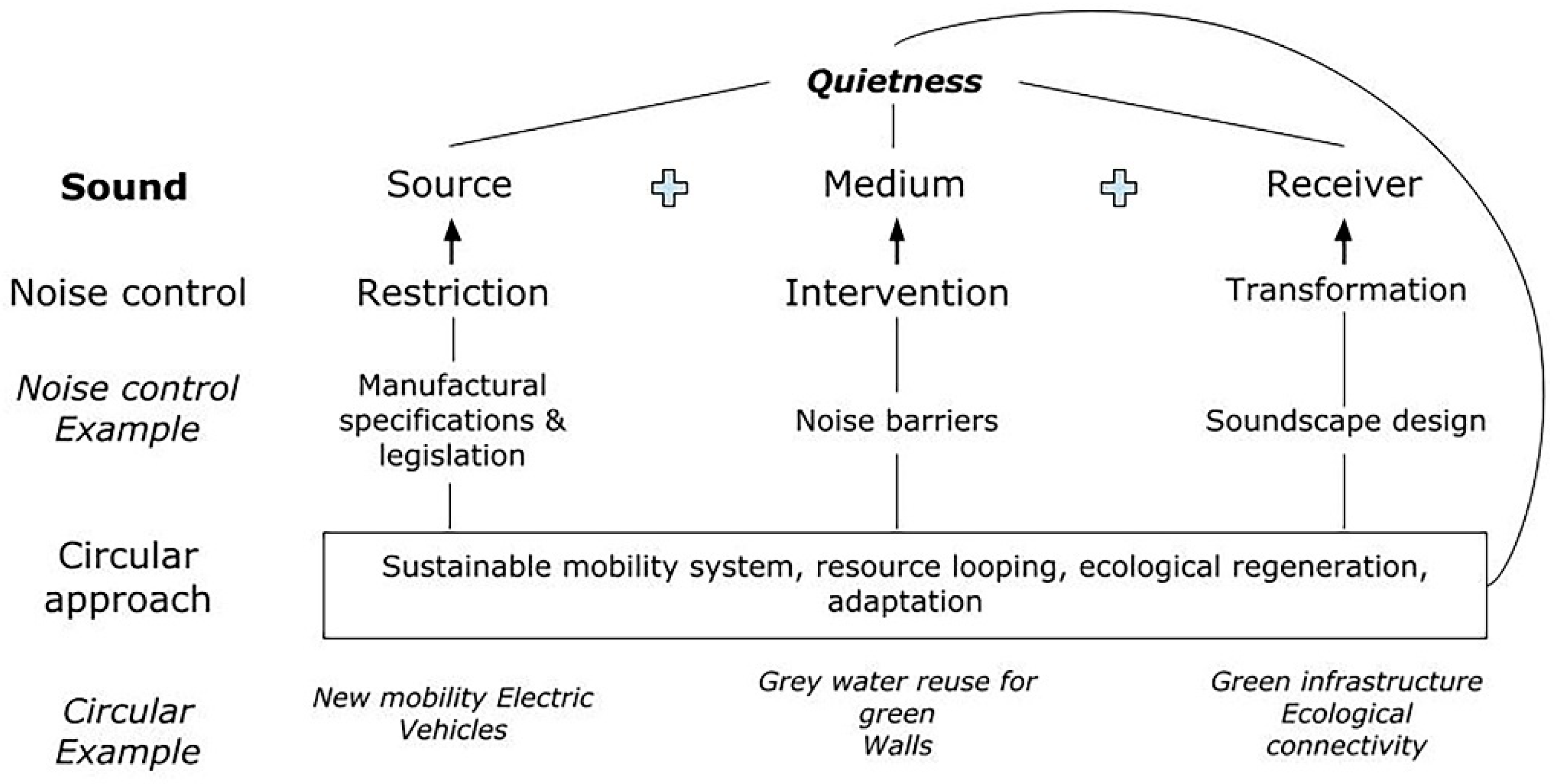
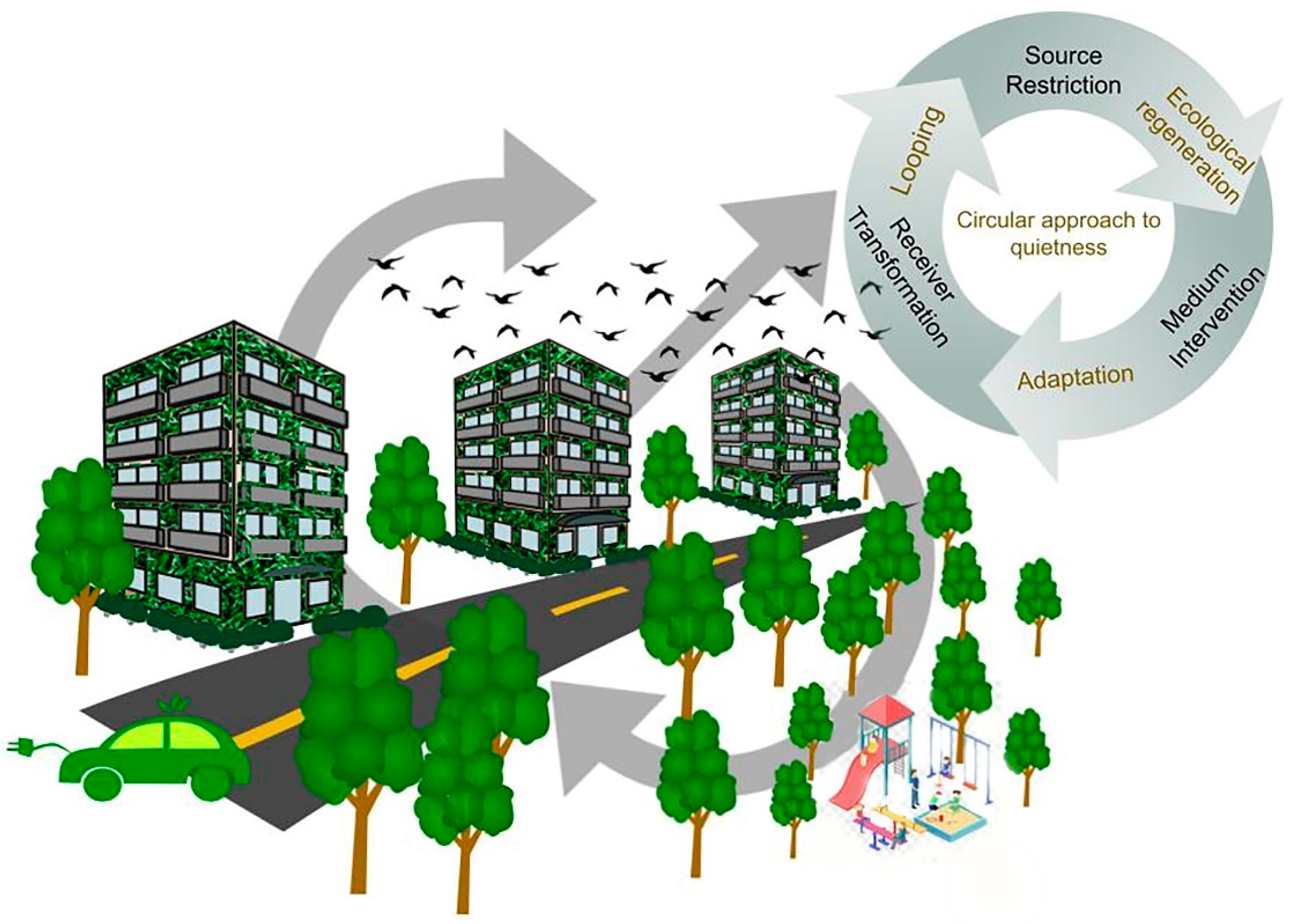

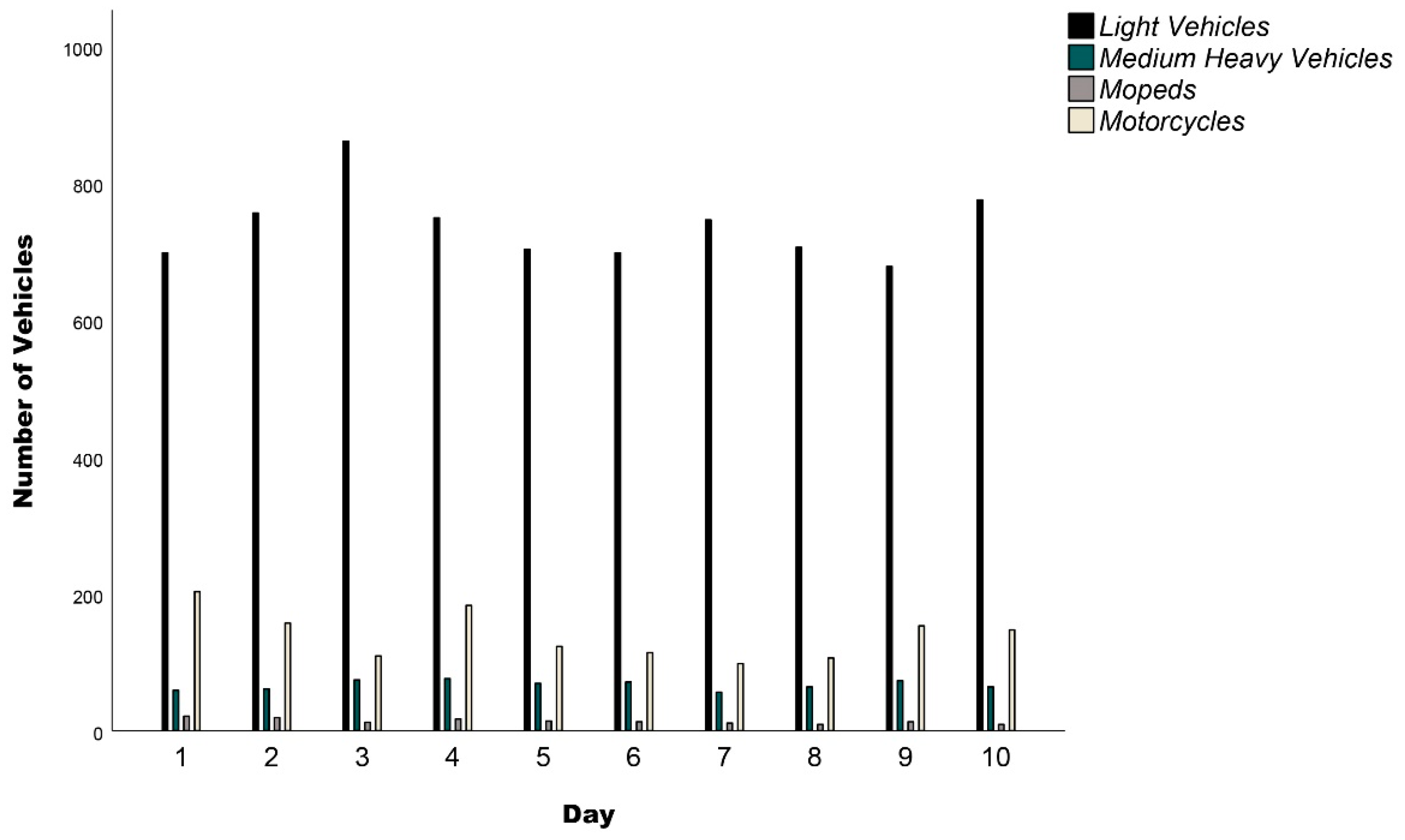
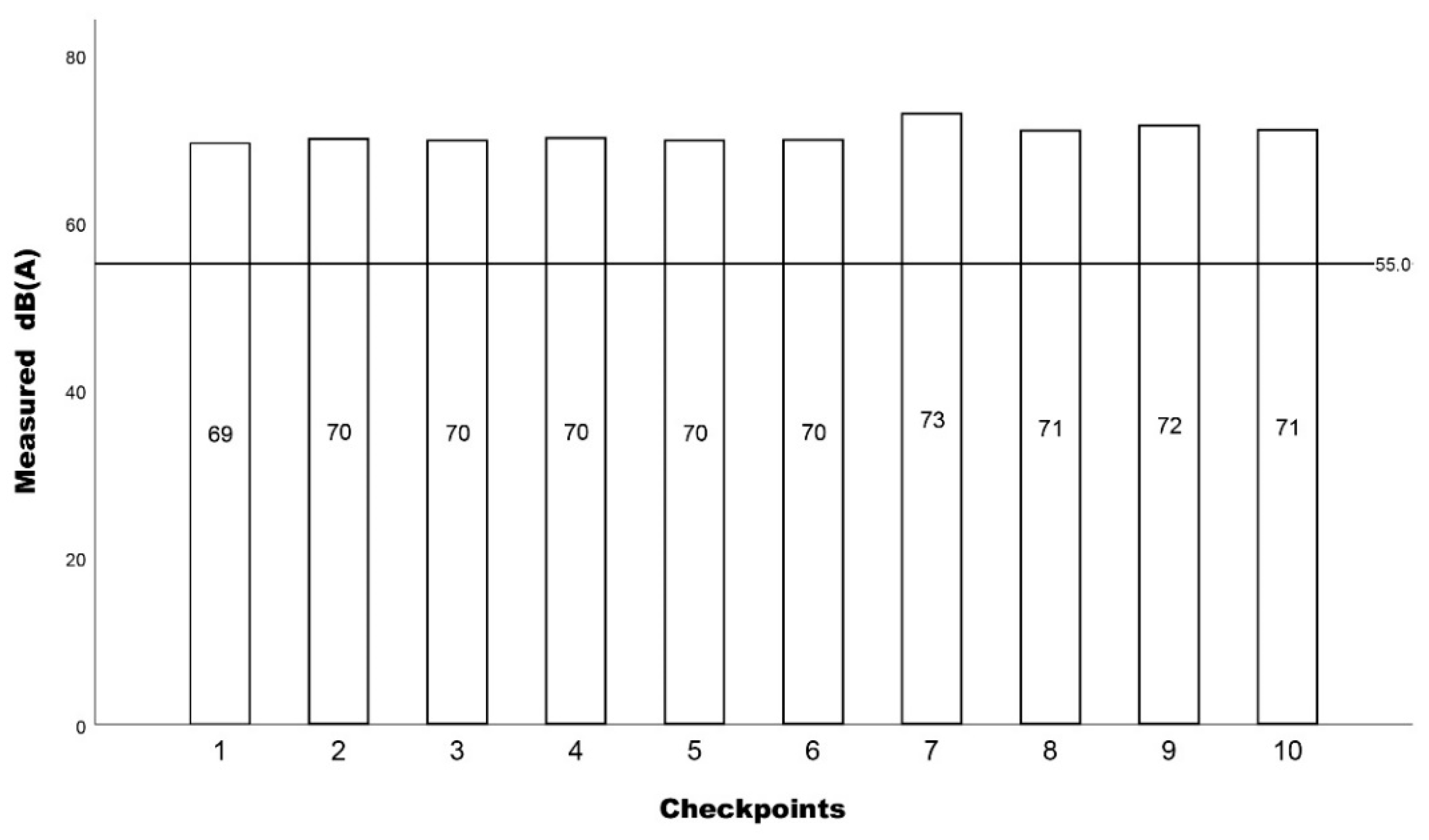

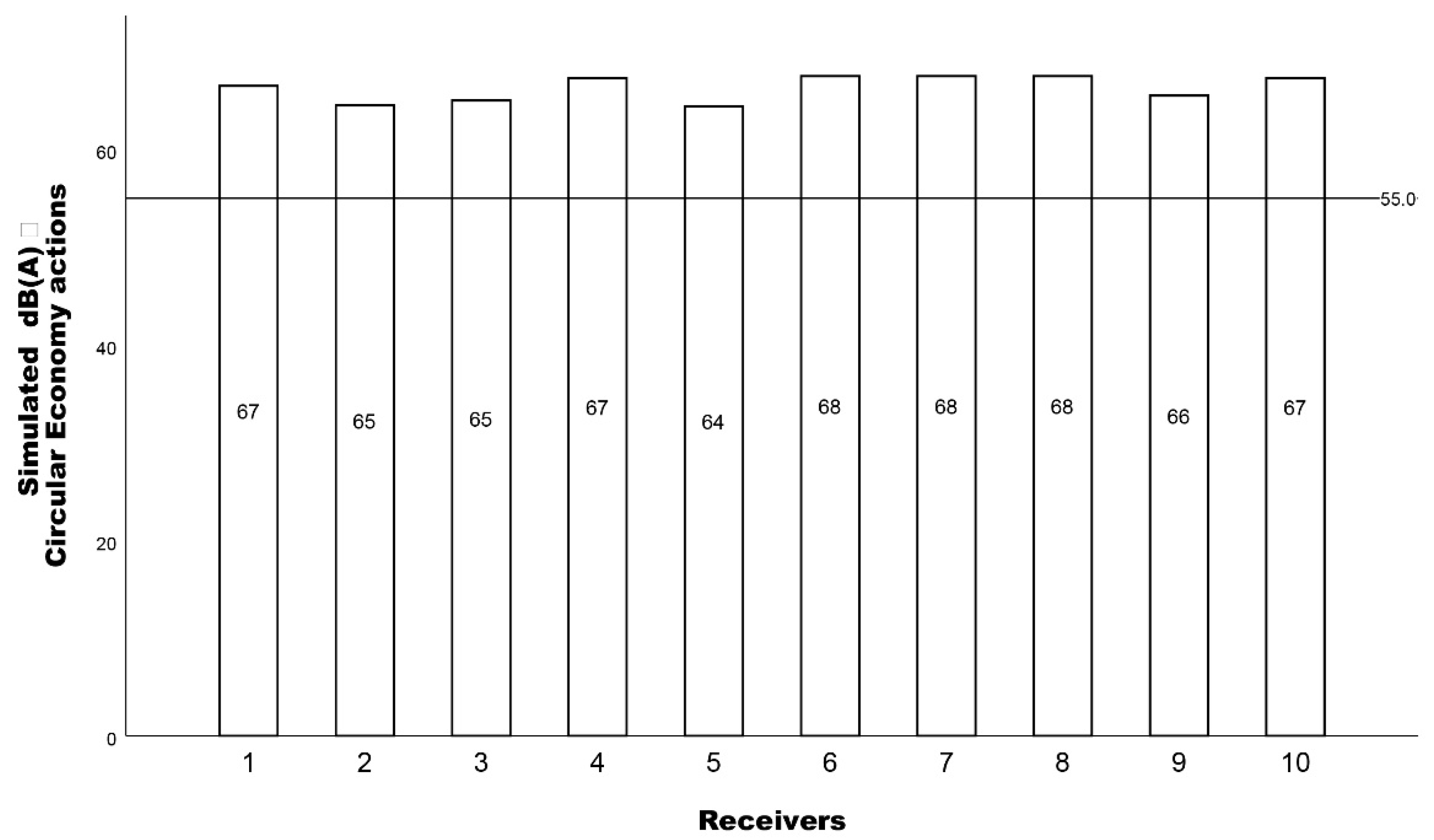
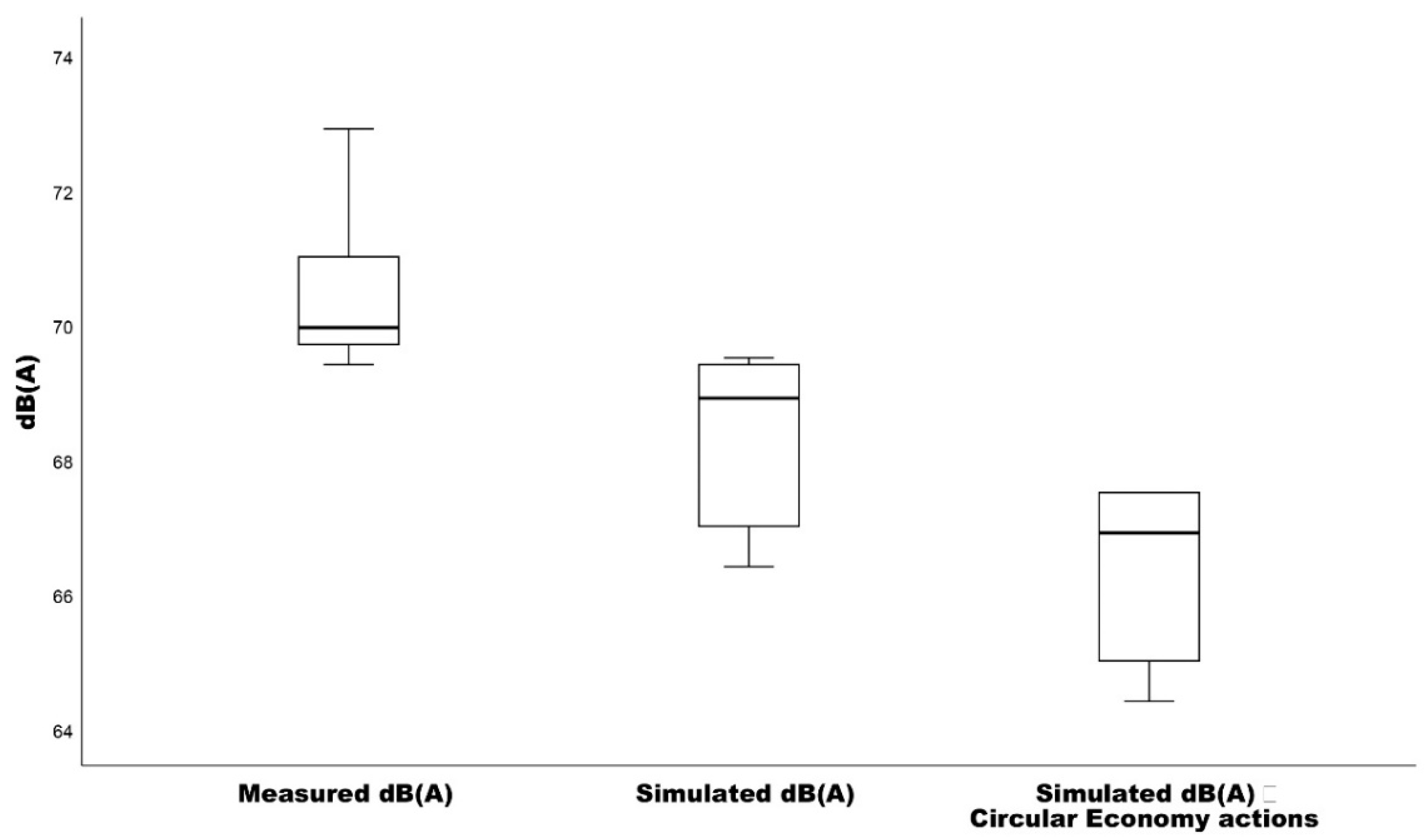


| Octave | Coefficients for Light ICE Vehicles | Correction Coefficients for EVs |
|---|---|---|
| 125 Hz | 85.7 dB | −1.7 dB |
| 250 Hz | 84.5 dB | −4.2 dB |
| 500 Hz | 90.2 dB | −15 dB |
| 1000 Hz | 97.3 dB | −15 dB |
| 2000 Hz | 93.9 dB | −15 dB |
| 4000 Hz | 84.1 dB | −13.8 dB |
| Descriptive Statistics | |||||||
|---|---|---|---|---|---|---|---|
| Leq Levels | Mean | SD | Min. | Max. | Skewness | Kurtosis | Variance |
| Measured dB(A) | 70.57 | 1.066 | 69.4 | 72.9 | 1.041 | 0.667 | 1.138 |
| Simulated dB(A) | 68.38 | 1.273 | 66.4 | 69.5 | −0.690 | −1.488 | 1.622 |
| Simulated Circular Economy dB(A) | 66.4 | 1.289 | 64.4 | 67.5 | −0.676 | −1.503 | 1.664 |
| Paired Samples Test | ||||||||||
|---|---|---|---|---|---|---|---|---|---|---|
| Leq Levels | Mean | SD | Std. Error Mean | 95% CI of the Difference | t | df | Sig. | Cohen’s d | ||
| Lower | Upper | |||||||||
| Pair 1 | Measured dB(A) | 2.19091 | 1.24856 | 0.37646 | 1.35211 | 3.02971 | 5.820 | 10 | <0.001 | 2.700 |
| Simulated dB(A) | ||||||||||
| Pair 2 | Measured dB(A) | 4.17273 | 1.25227 | 0.37757 | 3.33144 | 5.01401 | 11.051 | 10 | <0.001 | 4.875 |
| Simulated Circular Economy dB(A) | ||||||||||
| Pair 3 | Simulated dB(A) | 1.98182 | 0.04445 | 0.01220 | 1.95464 | 2.00899 | 162.488 | 10 | <0.001 | 70.124 |
| Simulated Circular Economy dB(A) | ||||||||||
Publisher’s Note: MDPI stays neutral with regard to jurisdictional claims in published maps and institutional affiliations. |
© 2022 by the authors. Licensee MDPI, Basel, Switzerland. This article is an open access article distributed under the terms and conditions of the Creative Commons Attribution (CC BY) license (https://creativecommons.org/licenses/by/4.0/).
Share and Cite
Tsaligopoulos, A.; Kyvelou, S.S.; Chiotinis, M.; Karapostoli, A.; Klontza, E.E.; Lekkas, D.F.; Matsinos, Y.G. The Sound of a Circular City: Towards a Circularity-Driven Quietness. Int. J. Environ. Res. Public Health 2022, 19, 12290. https://doi.org/10.3390/ijerph191912290
Tsaligopoulos A, Kyvelou SS, Chiotinis M, Karapostoli A, Klontza EE, Lekkas DF, Matsinos YG. The Sound of a Circular City: Towards a Circularity-Driven Quietness. International Journal of Environmental Research and Public Health. 2022; 19(19):12290. https://doi.org/10.3390/ijerph191912290
Chicago/Turabian StyleTsaligopoulos, Aggelos, Stella Sofia Kyvelou, Michalis Chiotinis, Aimilia Karapostoli, Eleftheria E. Klontza, Demetris F. Lekkas, and Yiannis G. Matsinos. 2022. "The Sound of a Circular City: Towards a Circularity-Driven Quietness" International Journal of Environmental Research and Public Health 19, no. 19: 12290. https://doi.org/10.3390/ijerph191912290
APA StyleTsaligopoulos, A., Kyvelou, S. S., Chiotinis, M., Karapostoli, A., Klontza, E. E., Lekkas, D. F., & Matsinos, Y. G. (2022). The Sound of a Circular City: Towards a Circularity-Driven Quietness. International Journal of Environmental Research and Public Health, 19(19), 12290. https://doi.org/10.3390/ijerph191912290











